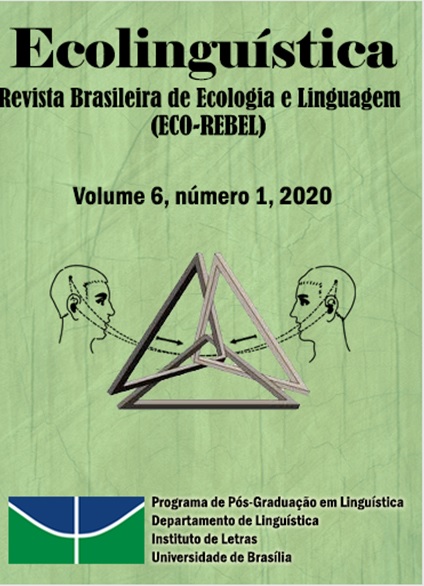Perspectives on a 2019 Tiger-Human Interaction Incident in Malaysia
Resumo
Este artigo descreve um incidente em 2019 na Malásia, no qual dois tigres foram vistos próximos a uma aldeia. Após apresentar o contexto sobre a situação dos tigres em nível internacional e na Malásia, o artigo apresenta um estudo de 10 artigos online sobre o incidente na mídia. As categorias usadas na análise dos artigos foram preocupação humana com os tigres, tigres de propriedade de humanos, tigres provocando medo, animais para diversão humana, tigres como criminosos, uso de pronomes para se referir aos tigres e apresentação do contexto dos tigres na Malásia. A análise mostrou que os artigos online refletiam uma perspectiva humano-cêntrica, que contrasta com a visão de humanos-como-parceiros-animais. Essa última visão é comparada a estudos mencionados sobre a perspectiva das pessoas na Índia rural e ao status de uma variedade de animais não humanos como pensantes, sencientes. Sugere-se que a adoção de uma perspectiva humanos-como-parceiros-animais pode ser importante para o bem-estar e continuidade da existência de tigres em estado selvagem, bem como a de outras espécies.
Downloads
Referências
Balcombe, J. (2016). What a fish knows: The inner lives of our underwater cousins. New York, NY: Scientific American / Farrar, Straus and Giroux, 2016.
Cappiello, E. This animal kills the most humans every year””and it’s not the one you’re thinking of. MSN. 2019. Retrieved from https://www.msn.com/en-us/lifestyle/lifestyle-buzz/this-animal-kills-the-most-humans-every-year%E2%80%94and-its-not-the-one-youre-thinking-of/ar-BBTbIYh
Channel News Asia. India's wild tiger population jumps to almost 3,000: Census, 2019. Retrieved from https://www.channelnewsasia.com/news/asia/india-wild-tiger-population-increase-census-11764094
Cutolo, M., & LaBianca, J. Animals that are deadlier than sharks. Readers’ Digest, 2019. Retrieved from https://www.rd.com/advice/travel/animals-that-are-deadlier-than-sharks/
Darwin, C. (1859/2004). On the origin of species. London, United Kingdom: Routledge.
de Waal, F. Are we smart enough to know how smart animals are? New York, NY: W.W. Norton, 2016.
Dhee, Arthreya, V., Linnell, J. D. C., Shivakumar, S., & Dhiman, S. P. (2019). The leopard that learnt from the cat and other narratives of carnivore”“human coexistence in northern India. People & Nature 1, 2019, p. 1-11. DOI: 10.1002/pan3.10039
D’Rozario, V. Tigers belong in the wild, not in our homes, the streets or farms. Channel News Asia, 2019. Retrieved from
https://www.channelnewsasia.com/news/commentary/tiger-population-in-asia-conservation-malaysia-road-walking-11766004
Dunayer, J. Animal equality: Language and liberation. Derwood, MA: Ryce Publishing, 2001.
Fitri Nizam. Terengganu loses millions to illegal logging, 2018. New Straits Times. Retrieved from https://www.nst.com.my/news/exclusive/2018/08/398094/exclusive-terengganu-loses-millions-illegal-logging
Harari, Y. N. Sapiens: A brief history of humankind. New York, NY: Harper, 2015.
Harari, Y. N. Homo deus: A brief history of tomorrow. London, United Kingdom: Vintage, 2017.
“India’s wild tiger population jumps”. Channel News Asia, 2019. Retrieved from https://www.channelnewsasia.com/news/india-wild-tiger-population-increase-census-11764094
Jasudon, P. In Malaysia, a bloody clash between man and beast, 2001. Washington Post. Retrieved from
https://www.washingtonpost.com/archive/politics/2001/02/11/in-malaysia-a-bloody-clash-between-man-and-beast/1aca2264-1f81-4ea4-90f1-f68896f28a9f/
Keim, B. Coexistence isn’t just about science and self-interest. It’s about stories, too. Anthropocene, 2019. Retrieved from
http://www.anthropocenemagazine.org/2019/08/narratives-of-coexistence
Sim, L. L. To save the Malayan tiger, poachers could be shot on sight, 2019. Retrieved from https://www.star2.com/living/2019/04/16/protecting-wildlife/
Society for the Prevention of Cruelty to Animals. Stop the cruelty in puppy mills, 2013. Retrieved from https://sgpuppies.com/
Steffen, W., Persson, Ã…., Deutsch, L., Zalasiewicz, J., Williams, M., Richardson, K., … & Svedin, U. The Anthropocene: From global change to planetary stewardship, 2011. Ambio, 40(7), 739-761. http://dx.doi.org/10.1007/s13280-011-0185-x
Stibbe, A. Ecolinguistics: Language, ecology, and the stories we live by. Abingdon, United Kingdom: Routledge, 2015.
Traffic Tigers: Fighting the illegal trade in tigers and their products, n.d. Retrieved from https://www.traffic.org/what-we-do/species/tigers
WWF. Urgent attention needed for global tiger recovery efforts, as Southeast Asia reports worrying gaps, 2019. Retrieved from http://www.wwf.org.my/media_and_information/updates__former_newsroom_main_/?uNewsID=26565
Downloads
Publicado
Como Citar
Edição
Seção
Licença
Autores que publicam nesta revista concordam com os seguintes termos:
Autores mantêm os direitos autorais e concedem à revista o direito de primeira publicação, sendo o trabalho simultaneamente licenciado sob a Creative Commons Attribution License o que permite o compartilhamento do trabalho com reconhecimento da autoria do trabalho e publicação inicial nesta revista.
Autores têm autorização para assumir contratos adicionais separadamente, para distribuição não exclusiva da versão do trabalho publicada nesta revista (ex.: publicar em repositório institucional ou como capítulo de livro), com reconhecimento de autoria e publicação inicial nesta revista.
Autores têm permissão e são estimulados a publicar e distribuir seu trabalho online (ex.: em repositórios institucionais ou na sua página pessoal) a qualquer ponto antes ou durante o processo editorial, já que isso pode gerar alterações produtivas, bem como aumentar o impacto e a citação do trabalho publicado (Veja O Efeito do Acesso Livre).



3.png)



